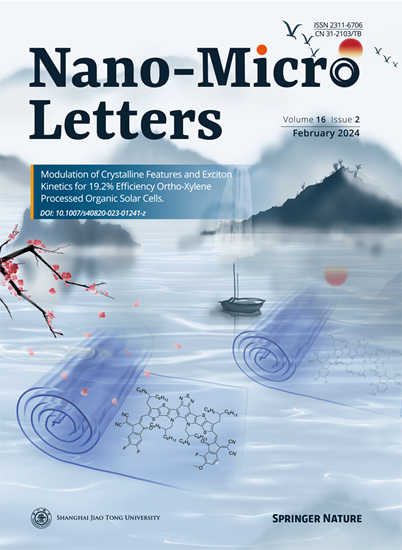Core–Shell IrPt Nanoalloy on La/Ni–Co3O4 for High-Performance Bifunctional PEM Electrolysis with Ultralow Noble Metal Loading
IF 36.3
1区 材料科学
Q1 Engineering
引用次数: 0
Abstract
Highlights
-
Core–shell IrPt nanoalloy on La/Ni–Co₃O₄ achieves unprecedented bifunctional activity (2 A cm−2 at 1.72 V) in proton exchange membrane water electrolysis (PEMWE) with ultralow loadings (0.075 mg cm−2 Ir/Pt at both electrodes).
-
646-h durability in PEMWE cell (5 μV h−1 decay) via IrPt-core@IrPtOx-shell synergy, hierarchical pores, and oxygen vacancies for robust electron/mass transfer and active-site stability.
-
In situ X-ray absorption spectroscopy combined with density functional theory unveils Ir–O–Pt sites enabling bi-nuclear oxygen evolution reaction and Volmer–Tafel hydrogen evolution reaction mechanisms through optimized Ir/Pt charge redistribution, breaking kinetic limitations.
La/Ni-Co3O4核壳IrPt纳米合金用于超低贵金属负载的高性能双功能PEM电解。
开发高效、耐用、贵金属用量少的双功能催化剂是推进质子交换膜水电解(PEMWE)的关键。我们提出了一种由镧和镍共掺杂钴氧化物支撑的铱铂纳米合金(IrPt),具有核壳结构,具有非晶IrPtOx壳和IrPt核。该催化剂在酸性介质中表现出优异的析氧和析氢双功能活性,在阳极和阴极分别为0.075 mgIr cm-2和0.075 mgPt cm-2的超低负载的PEMWE器件中,在1.72 V下分别达到2 A cm-2。它表现出优异的耐久性,持续水分解超过646 h,降解率仅为5 μV h-1,优于最先进的ir基催化剂。原位x射线吸收光谱和密度泛函理论模拟表明,优化的Ir和Pt之间的电荷再分配以及IrPt核- irptox壳结构提高了性能。Ir-O-Pt活性位点实现了析氧反应的双核机制和析氢反应的Volmer-Tafel机制,降低了动力学障碍。分层孔隙、丰富的氧空位和高电化学表面积进一步改善了电子和质量传递。这项工作为绿色制氢提供了一种经济有效的解决方案,并推动了PEMWE高性能双功能催化剂的设计。
本文章由计算机程序翻译,如有差异,请以英文原文为准。
求助全文
约1分钟内获得全文
求助全文
来源期刊

Nano-Micro Letters
NANOSCIENCE & NANOTECHNOLOGY-MATERIALS SCIENCE, MULTIDISCIPLINARY
CiteScore
32.60
自引率
4.90%
发文量
981
审稿时长
1.1 months
期刊介绍:
Nano-Micro Letters is a peer-reviewed, international, interdisciplinary, and open-access journal published under the SpringerOpen brand.
Nano-Micro Letters focuses on the science, experiments, engineering, technologies, and applications of nano- or microscale structures and systems in various fields such as physics, chemistry, biology, material science, and pharmacy.It also explores the expanding interfaces between these fields.
Nano-Micro Letters particularly emphasizes the bottom-up approach in the length scale from nano to micro. This approach is crucial for achieving industrial applications in nanotechnology, as it involves the assembly, modification, and control of nanostructures on a microscale.
 求助内容:
求助内容: 应助结果提醒方式:
应助结果提醒方式:


